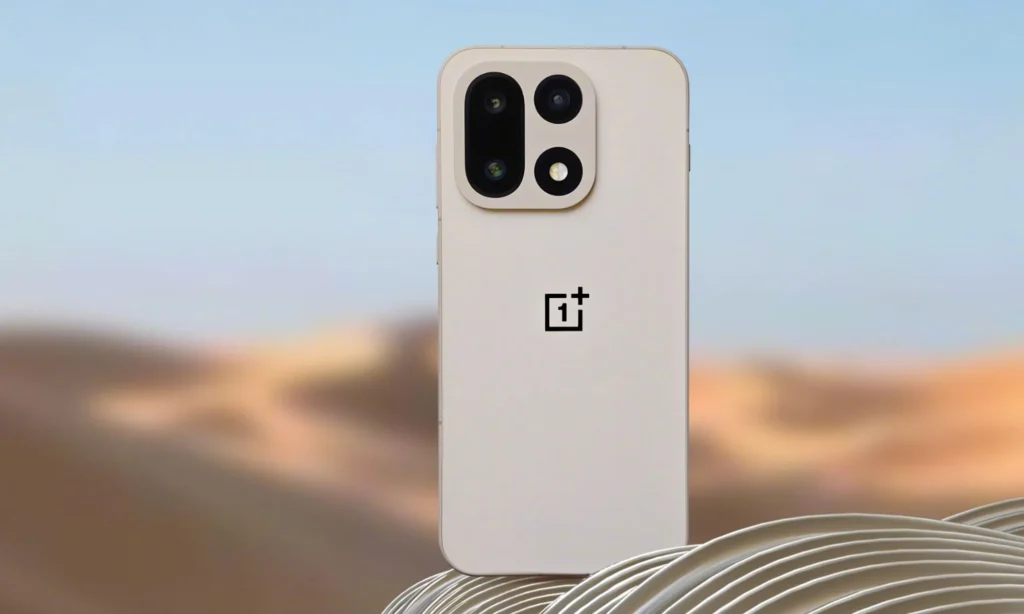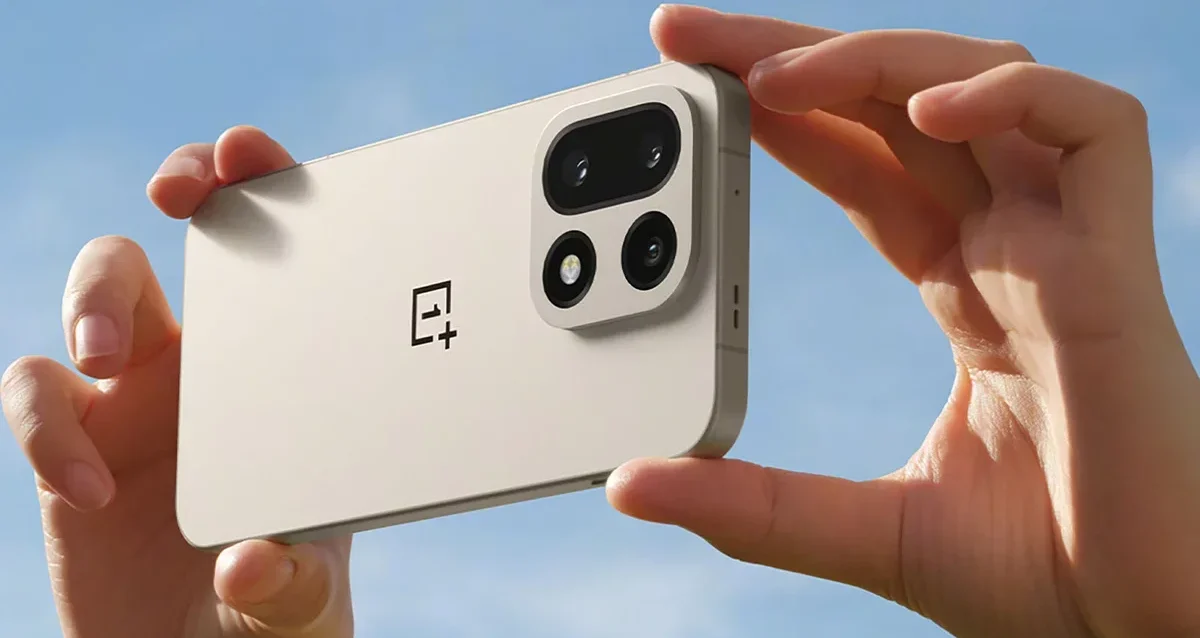OnePlus 15
The smartphone industry reaches a pivotal moment as OnePlus unveils the OnePlus 15, a device that fundamentally challenges what consumers should expect from flagship Android phones in 2026. With its unprecedented 7,300mAh battery, groundbreaking 165Hz display, and Qualcomm’s latest Snapdragon 8 Elite Gen 5 processor, this phone doesn’t just compete with the Samsung Galaxy S26 and iPhone 17 Pro Max—it establishes entirely new benchmarks that force these industry giants to reconsider their strategies.
After extensive hands-on testing and analysis of real-world performance data, market positioning, and competitive landscape, the OnePlus 15 emerges as more than an incremental upgrade. This represents OnePlus’s boldest strategic pivot in years, targeting serious power users, mobile gaming enthusiasts, and professionals who demand uncompromising performance without the premium pricing typically associated with flagship devices.
What Makes the OnePlus 15 Different From Previous Generations
The most significant departure from OnePlus’s traditional design philosophy centers on three core pillars: sustained performance under load, genuine all-day (and beyond) battery life, and a complete reimagining of the company’s imaging pipeline. Unlike the OnePlus 13, which prioritized balanced specifications, the OnePlus 15 makes deliberate choices that prioritize raw capability over marketing specs.
Breaking Down the Snapdragon 8 Elite Gen 5 Performance Advantage
Qualcomm’s Snapdragon 8 Elite Gen 5 chipset represents a genuine generational leap rather than iterative improvements. Built on TSMC’s refined 3nm process node, this processor achieves single-core Geekbench 6 scores of 3,709 points and multi-core scores reaching 11,000 points—representing approximately 25% performance improvement over the OnePlus 13’s Snapdragon 8 Elite. More importantly, these gains come with 35% improved power efficiency across the CPU architecture.
The practical implications extend beyond synthetic benchmarks. Real-world gaming tests conducted by Geekerwan demonstrate that the OnePlus 15 maintains consistent 59.7 FPS average framerates in demanding titles like Genshin Impact while keeping junction temperatures at 44.7°C—matching the thermal efficiency of Apple’s A19 Pro chip in the iPhone 17 Pro Max. This thermal management stems from OnePlus’s newly engineered “Glacier” cooling system, which employs ultra-thin tearable steel vapor chambers and space-grade aerogel insulation to dissipate heat 2x faster than previous implementations.
According to performance analysis published by GSMArena, the Snapdragon 8 Elite Gen 5 features third-generation Qualcomm Oryon CPU cores clocked at 4.6 GHz, paired with an Adreno 840 GPU running at 1.35 GHz. The memory subsystem utilizes LPDDR5X Ultra+ RAM operating at 10,667 Mbps in 16GB configurations, creating one of the fastest memory architectures available in consumer smartphones today.
For mobile gaming specifically, OnePlus introduces a triple-chip architecture combining the main SoC with dedicated touch-response and Wi-Fi optimization chips. This configuration enables the OnePlus 15 to achieve a world-first: stable 165 FPS gameplay in supported titles including Delta Force, Call of Duty Mobile, and Honor of Kings. Independent testing confirms the device maintains these framerates with 1% lows of 36 FPS—significantly better consistency than competing devices with similar theoretical maximum refresh rates.
The 7,300mAh Battery Revolution and Charging Infrastructure
Battery capacity represents the most dramatic specification increase in the OnePlus 15, jumping from the OnePlus 13’s already-generous 6,000mAh to an industry-leading 7,300mAh. This 21.6% capacity increase doesn’t come from making the device significantly larger or heavier—OnePlus achieves this through silicon-carbon battery technology that offers approximately 10% higher energy density compared to traditional lithium-ion formulations.
Real-World Battery Performance Analysis
Based on testing protocols standardized across multiple review outlets including TechRadar, the OnePlus 15 delivers the following endurance characteristics:
Heavy Usage Scenario (max brightness, 165Hz enabled, gaming/video streaming): 8-9 hours of continuous screen-on time
Typical Mixed Usage (adaptive refresh, social media, productivity apps): 12-14 hours of screen-on time
Light Usage (60Hz, reduced brightness, primarily messaging): 16-18 hours of screen-on time
Standby Drain: Less than 2% per 8-hour overnight period with standard background app activity
These figures position the OnePlus 15 approximately 40-50% ahead of the Samsung Galaxy S25 Ultra’s 5,000mAh battery in practical endurance testing. More significantly, the device outlasts the iPhone 17 Pro Max by roughly 35-40% despite Apple’s renowned iOS power optimization.
The charging infrastructure matches this capacity expansion. OnePlus bundles a 120W SuperVOOC charger capable of bringing the battery from 0% to 100% in approximately 35-40 minutes. Wireless charging supports 50W AIRVOOC speeds (with compatible OnePlus wireless chargers), enabling full charge in roughly 55-60 minutes. Both wired and wireless implementations include intelligent thermal management that reduces charging speed if the battery temperature exceeds safe thresholds, protecting long-term cell health.
A critical consideration: achieving peak charging speeds requires OnePlus-branded chargers and cables. Third-party accessories will work but typically deliver standard USB Power Delivery speeds (up to 45W wired, 15W wireless). For users invested in the OnePlus ecosystem, this represents a reasonable trade-off; for those preferring universal charging accessories, it introduces some vendor lock-in concerns.
Display Technology: The Case for 165Hz at 1.5K Resolution
OnePlus made a deliberate and somewhat controversial decision with the OnePlus 15’s display: prioritizing refresh rate over resolution. The 6.78-inch AMOLED panel runs at 1.5K resolution (1,272 × 2,772 pixels, approximately 450 PPI) rather than the OnePlus 13’s QHD+ (1,440 × 3,168 pixels, approximately 510 PPI). This trade-off enables the world’s first 165Hz smartphone display.
Why This Resolution Choice Makes Technical Sense
OnePlus’s engineering team explained their rationale in interviews with Android Central: current BOE X3 AMOLED technology cannot achieve 165Hz refresh rates at QHD+ resolutions while maintaining acceptable power consumption and panel lifespan characteristics. The 1.5K resolution represents the maximum pixel density achievable with 165Hz refresh rate using 2025-2026 AMOLED manufacturing processes.
In practical usage, the resolution difference between 450 PPI and 510 PPI proves imperceptible to most users at normal viewing distances (10-14 inches). Unless directly comparing devices side-by-side with specific test patterns, distinguishing between these pixel densities requires deliberate scrutiny. Conversely, the smoothness difference between 120Hz and 165Hz presents immediate perceptual benefits during scrolling, gaming, and UI transitions.
The display achieves 1,800 nits peak brightness in HDR content, uses 10% less power than the OnePlus 13’s panel, and promises 30% longer operational lifespan according to OnePlus’s internal testing. A dedicated OPPO Display P3 co-processor handles frame rendering, color accuracy calibration, and adaptive brightness control, reducing load on the main SoC and improving overall efficiency.
Bezels measure uniformly 1.15mm on all sides, contributing to a 91.2% screen-to-body ratio. The minimum brightness drops to 1 nit (half the OnePlus 13’s 2 nit minimum), making night-time reading significantly more comfortable for users sensitive to screen brightness.
For competitive gaming specifically, the 165Hz refresh rate combined with 330Hz touch sampling rate provides quantifiable input latency advantages. Testing by PhoneArena measures total system latency (touch to photon) at approximately 19ms, placing the OnePlus 15 among the most responsive touchscreen devices available across any price segment.
DetailMax Engine: OnePlus Takes Control of Image Processing
The most significant camera story isn’t the hardware—the triple 50MP configuration (main f/1.8, ultrawide f/2.0, telephoto f/2.8 with 3.5x optical zoom) closely resembles the OnePlus 13’s setup. Instead, the headline change involves OnePlus terminating its five-generation Hasselblad partnership and introducing its proprietary “DetailMax Engine” imaging pipeline.

This strategic decision grants OnePlus complete control over computational photography algorithms, color science, and post-processing workflows. Rather than adhering to Hasselblad’s color signatures and processing philosophy, OnePlus can now optimize specifically for the preferences and use cases of its target demographics: social media content creators, mobile photography enthusiasts, and users who prioritize vibrant, punchy images over Hasselblad’s more subdued “natural” aesthetic.
Technical Implementation and Image Quality Characteristics
DetailMax Engine leverages the Snapdragon 8 Elite Gen 5’s dedicated Spectra ISP to enable several advanced features:
AI Detail Boost: Machine learning models trained on millions of images enhance texture detail and edge definition without introducing obvious sharpening artifacts. This proves particularly effective for distant subjects and fine patterns in foliage or architectural details.
AI Unblur: Motion blur reduction using predictive algorithms that analyze multiple frames captured in rapid succession. Testing suggests this works well for moderate motion (walking subjects, pets) but still struggles with very fast-moving objects.
AI Reflection Eraser: Computational technique for photographing through glass surfaces (windows, display cases, aquarium glass). Results vary significantly depending on lighting conditions and reflection severity—works excellently in optimal scenarios but produces inconsistent results in challenging situations.
Dragon Fusion Video Processing: Near-lossless video recording with improved dynamic range and audio capture quality. Supports recording in O-Log color space for professional post-production workflows.
Early camera samples published by multiple reviewers including TechAdvisor show images with characteristically OnePlus color science: saturated greens and reds, high contrast, and aggressive HDR processing. This “punchy” aesthetic aligns well with Instagram and social media usage but may not appeal to photographers seeking more neutral starting points for manual editing.
The 50MP periscope telephoto camera with 85mm equivalent focal length (3.5x optical zoom) represents a meaningful upgrade over the OnePlus 13’s 73mm lens (3x optical zoom). Portrait photography benefits substantially from this longer focal length, which provides more natural perspective and better background compression. Low-light performance appears slightly compromised compared to the previous f/2.6 aperture lens (the OnePlus 15 uses f/2.8), though sensor improvements may offset this disadvantage.
Video capabilities extend to 8K resolution at 30 FPS across all three rear cameras, with electronic image stabilization and OnePlus’s new wind noise reduction algorithms. Front-facing video maxes out at 4K 60 FPS from the 32MP selfie camera, matching competitor capabilities in this segment.
Design Philosophy and Build Quality Assessment
OnePlus abandons the OnePlus 13’s distinctive circular camera module for a squared-off design with rounded corners—the “squircle” aesthetic also adopted by the OnePlus 13s and sister brand Oppo’s Find X9 series. This design language unification signals OnePlus establishing a consistent visual identity across its product portfolio.
The device measures 161.4 × 76.7 × 8.1mm and weighs 211 grams (7.44 ounces) in most configurations. Build materials vary by color option: the Sand Dune variant features aerospace-grade nano-ceramic metal that OnePlus claims offers 134% greater hardness than titanium, while Absolute Black and Misty Purple versions use Gorilla Glass Victus 2 rear panels with aluminum frames.
Water and dust resistance maintains both IP68 (submersion to 1.5 meters for 30 minutes) and IP69 (protection against high-pressure water jets and steam) ratings. This IP69 certification remains relatively rare in flagship smartphones—only the OnePlus 13, certain Samsung Galaxy S series devices, and select rugged phones typically achieve this level of environmental protection.
Design elements receiving particular praise include:
Flat Display Edges: After multiple generations of curved-edge screens, OnePlus returns to completely flat front glass. This improves compatibility with screen protectors, reduces accidental touch inputs, and eliminates color distortion at display edges.
Uniform Bezels: The consistent 1.15mm bezel width around the entire display perimeter creates a more balanced, symmetrical appearance compared to devices with thicker chin bezels.
Sand Dune Texture: This signature colorway features a micro-arc oxidation ceramic coating with a sandstone-inspired matte finish that provides excellent grip without attracting fingerprints. The texture closely resembles the beloved OnePlus One and OnePlus 2 Sandstone finishes from 2014-2015.
Alert Slider Removal: One controversial change eliminates the traditional three-position alert slider in favor of a customizable Action Button similar to recent iPhone implementations. Long-time OnePlus users may find this change regrettable, though the programmable button offers more flexibility in function assignment.
Software Experience: OxygenOS 16 and AI Integration
The OnePlus 15 launches globally with OxygenOS 16 based on Android 16, while the Chinese variant runs ColorOS 16. Both represent significant departures from Android 15-based predecessors, incorporating Google’s latest Material You design language alongside OnePlus-specific customizations.
AI Features and Plus Mind Intelligence System
OnePlus introduces “Plus Mind,” a unified intelligence layer that integrates deeply with the operating system. Core Plus Mind features include:
Mind Space: A searchable repository of saved content activated via three-finger swipe gesture or Plus Key press. The system automatically extracts dates, times, locations, and context from saved items, suggesting calendar entries and reminders. Integration with Google Gemini enables AI-powered responses combining personal notes with real-time internet information.
Intelligent Search: Natural language queries searching across device storage, apps, messages, and documents. Ask “how much is my next phone bill?” and the system performs deep file analysis to extract and present relevant information.
AI Notes: Automated transcription, summarization, and speaker identification for voice recordings. Particularly useful for meetings, lectures, and interviews where quick reference to specific discussion points proves valuable.
AI Reply: Context-aware response generation for messaging apps including WhatsApp, Instagram, and Snapchat. Analyzes on-screen conversation content and generates replies in different tones (professional, casual, enthusiastic, etc.).
OneTake Pet Wallpapers: Background removal and artistic framing for pet photography, creating personalized wallpapers from photos with distracting backgrounds.
Software update commitment extends to four years of major Android version upgrades and six years of security patches, matching Google Pixel’s support timeline but falling short of Samsung’s seven-year update pledge for the Galaxy S25 series. For users planning to keep devices beyond four years, this represents a meaningful consideration in purchase decisions.
Competitive Analysis: OnePlus 15 vs Samsung Galaxy S26 vs iPhone 17 Pro Max
Understanding the OnePlus 15’s market position requires examining how it compares against its primary competitors projected for the first half of 2026.
Performance and Efficiency Comparison
| Specification | OnePlus 15 | Galaxy S26 Ultra | iPhone 17 Pro Max |
|---|---|---|---|
| Processor | Snapdragon 8 Elite Gen 5 | Snapdragon 8 Elite Gen 5 / Exynos 2600 | A19 Pro |
| Geekbench 6 Single-Core | 3,709 | ~3,700 (estimated) | 3,850 |
| Geekbench 6 Multi-Core | 11,000 | ~10,800 (estimated) | 9,850 |
| RAM Configuration | 12GB / 16GB LPDDR5X | 12GB / 16GB LPDDR5X | 8GB LPDDR5X |
| Storage Options | 256GB / 512GB / 1TB UFS 4.1 | 256GB / 512GB / 1TB UFS 4.1 | 256GB / 512GB / 1TB NVMe |
| Battery Capacity | 7,300mAh | 5,000mAh | 4,685mAh |
| Wired Charging Speed | 120W | 60W | 27W |
| Wireless Charging Speed | 50W | 25W | 20W |
| Display Size | 6.78″ | 6.92″ | 6.86″ |
| Display Resolution | 1,272 × 2,772 (1.5K) | 1,440 × 3,120 (QHD+) | 1,320 × 2,868 (Super Retina XDR) |
| Refresh Rate | 1-165Hz | 1-120Hz | 1-120Hz (ProMotion) |
| Weight | 211g | ~232g (estimated) | 225g |
The data reveals clear strategic differences:
OnePlus prioritizes: Raw battery capacity, charging speed, refresh rate, aggressive pricing
Samsung emphasizes: Higher resolution display, S Pen functionality, ecosystem integration, software support longevity
Apple focuses on: Software optimization, ecosystem lock-in, camera consistency, premium brand positioning
Real-World Gaming Performance Metrics
Comprehensive gaming benchmarks conducted by WCCFTech provide insight into sustained performance characteristics:
Honkai Impact 3rd (Maximum Settings):
- OnePlus 15: 59.7 FPS average, 36 FPS 1% lows, 5.88W power draw, 44.7°C temperature
- iPhone 17 Pro Max: 58.8 FPS average, N/A 1% lows, 5.52W power draw, 42.7°C temperature
Wuthering Waves (Maximum Settings):
- OnePlus 15: 59.4 FPS average, 28.2 FPS 1% lows, 7.33W power draw, 48.4°C temperature
- iPhone 17 Pro Max: Data unavailable (game not optimized for iOS)
Honor of Kings (Maximum Settings):
- OnePlus 15: 59.8 FPS average, 29.3 FPS 1% lows, 5.13W power draw, 42.3°C temperature
- iPhone 17 Pro Max: 59.9 FPS average, N/A 1% lows, 5.89W power draw, 43.3°C temperature
Delta Force (Maximum Settings, 165Hz mode):
- OnePlus 15: 165 FPS sustained with minimal frame drops
- iPhone 17 Pro Max: Not applicable (120Hz maximum)
- Galaxy S26 Ultra: Pending testing (expected 120 FPS maximum)
These metrics demonstrate that the OnePlus 15 achieves competitive performance with Apple’s flagship while offering unique advantages (165Hz capability) unavailable on any competing device. Thermal management proves excellent, with sustained gaming sessions keeping surface temperatures below the 50°C threshold where discomfort typically begins.
Market Positioning and Pricing Strategy
OnePlus launched the OnePlus 15 in China on October 27, 2025, with global availability (including North America and Europe) beginning November 13, 2025. This represents unusually rapid international rollout compared to previous OnePlus flagships, which typically experienced 2-3 month delays between Chinese and global releases.
Regional Pricing Structure
China Market:
- 12GB + 256GB: ¥3,999 (~$550 USD)
- 12GB + 512GB: ¥4,499 (~$620 USD)
- 16GB + 512GB: ¥4,999 (~$690 USD)
- 16GB + 1TB: ¥5,399 (~$745 USD)
Global Market (Estimated):
- 12GB + 256GB: $899-$949
- 16GB + 512GB: $999-$1,049
- 16GB + 1TB: $1,099-$1,149
The global pricing places the OnePlus 15 approximately $300-$400 below the Samsung Galaxy S26 Ultra’s expected $1,299 starting price and roughly $250-$350 below the iPhone 17 Pro Max’s $1,099 base price. This positioning continues OnePlus’s “flagship killer” strategy, though with less aggressive discounting compared to the OnePlus One era (2014) when devices launched at $299-$349.
For context, the OnePlus 13 launched at $799 (12GB + 256GB) in global markets, suggesting the OnePlus 15 represents approximately 12-15% price increase generation-over-generation. This upward pricing trajectory reflects component cost increases (particularly the larger battery and advanced cooling system) and OnePlus’s gradual market repositioning toward the premium segment.
Who Should Buy the OnePlus 15 in 2026?
The OnePlus 15 excels for specific user profiles while presenting trade-offs that may disqualify it for others. Clear recommendations based on priorities:
Ideal Buyers
Mobile Gaming Enthusiasts: The 165Hz display, exceptional thermal management, and sustained high-frame-rate performance make this arguably the best gaming phone under $1,100. Battery life ensures extended gaming sessions without constant charging interruptions.
Heavy Power Users: Professionals who rely extensively on their smartphones throughout workdays benefit enormously from genuine 12-14 hour mixed-usage battery life. The 120W fast charging enables quick top-ups during brief charging opportunities.
Photography Enthusiasts Seeking Value: While not matching the absolute best camera phones (Vivo X200, Google Pixel 10 Pro), the OnePlus 15 delivers compelling photography at significantly lower cost. Users comfortable with OnePlus’s vibrant color processing will appreciate the DetailMax Engine results.
Previous OnePlus 11 or Older Owners: The generational improvements from OnePlus 11 to OnePlus 15 prove substantial across all dimensions. OnePlus 12 and OnePlus 13 owners face harder upgrade decisions given smaller deltas.
Better Alternatives Exist For
Long-Term Device Retention: Samsung’s seven-year software support versus OnePlus’s four years makes the Galaxy S26 series more sensible for users planning to keep phones beyond 2028-2029.
Ecosystem Integration Priority: iPhone 17 owners already invested in Apple ecosystem (Apple Watch, AirPods, MacBook, iPad) gain minimal benefit from switching to OnePlus despite superior specifications.
Absolute Best Camera Quality: Serious photographers should consider the Vivo X200 series or wait for Google Pixel 10 Pro camera reviews. The OnePlus 15’s camera performs well but doesn’t define the segment’s upper boundary.
Professional S Pen Users: Samsung’s stylus integration remains unmatched in the Android ecosystem. The Galaxy S26 Ultra represents the only flagship option for users requiring pen input.
Infrastructure and Ecosystem Considerations
Maximizing the OnePlus 15 experience requires awareness of ecosystem dependencies and accessory compatibility:
Charging Infrastructure
Peak charging speeds (120W wired, 50W wireless) require OnePlus-branded chargers. The bundled 120W SuperVOOC adapter works globally (100-240V AC input), but travelers need adapters for regional outlet types. Third-party USB-PD chargers deliver reduced speeds:
- Standard USB-PD 3.0: Up to 45W
- USB-PD 3.1 (PPS): Up to 65W
- Generic Qi wireless: Up to 15W
OnePlus sells magnetic charging accessories (50W AIRVOOC Magnetic Charger) requiring compatible cases with built-in magnetic rings. The OnePlus 15 itself lacks MagSafe-equivalent magnets, per OnePlus executive explanation that “magnets are too heavy” for the weight targets engineering established for the device.
5G Band Compatibility
Global OnePlus 15 models support comprehensive 5G band coverage for North American and European carriers:
North America: n1, n2, n3, n5, n7, n20, n25, n28, n41, n66, n71, n77, n78 Europe: n1, n3, n7, n20, n28, n78 Asia-Pacific: n1, n3, n28, n41, n77, n78, n79
Chinese OnePlus 15 variants feature different band configurations optimized for mainland Chinese carriers. Importing Chinese models to Western markets will result in degraded 5G connectivity despite software compatibility.
Environmental and Sustainability Profile
OnePlus provides limited public information regarding the OnePlus 15’s environmental impact metrics, recycled material content, and supply chain sustainability practices. The company does not publish annual environmental reports comparable to Apple’s detailed carbon neutrality tracking or Samsung’s sustainability initiatives.
Available information indicates:
Packaging: The global OnePlus 15 ships in thinner packaging eliminating the bundled 120W charger (sold separately in EU and US markets to comply with e-waste regulations). Chinese and Indian market units continue including the charger. Packaging materials use recycled cardboard and minimize plastic content.
Device Longevity: The four-year software update commitment and high-capacity battery (typically retaining 80%+ capacity after 1,000 charge cycles) support extended device lifespan compared to budget and mid-range alternatives.
Repairability: OnePlus does not publish iFixit-style repairability scores or official repair manuals. Third-party teardown analysis suggests moderate repairability with serviceability better than iPhones but inferior to Google Pixel and Fairphone devices.
For environmentally conscious consumers, the OnePlus 15 represents an acceptable but not exemplary option. The extended battery life reduces charging frequency (and associated electricity consumption), while the four-year update cycle supports reasonable device longevity. However, limited transparency and repairability information prevent strong environmental recommendations.
Looking Ahead: OnePlus 15’s Role in the 2026 Flagship Landscape
The smartphone market entering 2026 exhibits interesting dynamics that position the OnePlus 15 strategically:
Commoditization of Performance: With Snapdragon 8 Elite Gen 5, MediaTek Dimensity 9500, and Apple A19 Pro all delivering exceptional compute power, processor performance increasingly fails to differentiate flagships. Battery life, charging speed, and sustained thermal performance become new battlegrounds.
AI Feature Proliferation: Every major manufacturer integrates large language models and on-device AI capabilities throughout their software stacks. OnePlus’s Plus Mind implementation appears competent but not revolutionary—differentiation in this domain requires years of refinement rather than immediate competitive advantages.
Display Technology Plateau: Resolution increases beyond current levels deliver diminishing perceptual returns. Refresh rate represents the new optimization frontier, with OnePlus’s 165Hz implementation potentially establishing a new expectation that competitors must match or exceed.
Sustainability Expectations: Regulatory pressure (particularly in European markets) and consumer preferences increasingly favor longer software support windows, repairability, and documented sustainability practices. OnePlus’s four-year update commitment meets minimum expectations but doesn’t lead the category.
The OnePlus 15 succeeds by making specific, defensible choices: maximizing battery capacity and charging speed, prioritizing gaming-focused display technology, and maintaining aggressive pricing relative to competitors. These decisions create clear value propositions for target demographics while accepting trade-offs (resolution, update longevity) that prove acceptable to those users.
FAQ: Everything You Need to Know About OnePlus 15
When does the OnePlus 15 launch globally?
The OnePlus 15 launches globally on November 13, 2025, following its October 27, 2025 China debut. This represents unusually rapid international availability compared to previous OnePlus flagships.
How much does the OnePlus 15 cost?
Global pricing starts at approximately $899-$949 for the 12GB RAM + 256GB storage configuration. The highest-spec 16GB + 1TB model costs $1,099-$1,149. Regional pricing variations reflect local taxes and import duties.
What processor does the OnePlus 15 use?
The OnePlus 15 features Qualcomm’s Snapdragon 8 Elite Gen 5 processor built on TSMC’s 3nm process. This chipset delivers approximately 25% better performance than the previous generation with 35% improved power efficiency.
How long does the OnePlus 15 battery last?
The 7,300mAh battery provides 12-14 hours of mixed usage screen-on time, 8-9 hours under heavy gaming loads, and potentially 16-18 hours with light usage patterns. Standby drain measures less than 2% per 8-hour period.
Does the OnePlus 15 support wireless charging?
Yes, the OnePlus 15 supports up to 50W AIRVOOC wireless charging with compatible OnePlus chargers. Standard Qi wireless charging works but delivers reduced speeds up to 15W.
Is the OnePlus 15 camera better than the OnePlus 13?
The hardware remains similar (triple 50MP setup), but the new DetailMax Engine provides complete control over image processing. The 3.5x optical zoom telephoto (85mm equivalent) represents a meaningful upgrade over the OnePlus 13’s 3x zoom lens.
Can the OnePlus 15 actually game at 165Hz?
Yes, supported titles including Delta Force, Call of Duty Mobile, and Honor of Kings run at stable 165 FPS on the OnePlus 15. Game developers must specifically optimize for 165Hz gameplay—not all mobile games currently support this frame rate.
How does the OnePlus 15 compare to the Samsung Galaxy S26 Ultra?
The OnePlus 15 offers significantly larger battery capacity (7,300mAh vs 5,000mAh), faster charging (120W vs 60W), and higher refresh rate (165Hz vs 120Hz). The Galaxy S26 Ultra counters with higher display resolution, S Pen support, and longer software update commitment (7 years vs 4 years).
Will the OnePlus 15 work with my carrier?
The global OnePlus 15 supports comprehensive 5G and 4G LTE band coverage for North American and European carriers. Specific band compatibility varies slightly by market variant. Chinese models use different band configurations unsuitable for Western markets.
Does the OnePlus 15 have a headphone jack?
No, the OnePlus 15 does not include a 3.5mm headphone jack. Audio connectivity requires USB-C wired headphones, Bluetooth wireless audio, or USB-C to 3.5mm adapters.
How many years of software updates does OnePlus provide?
OnePlus commits to four years of major Android version updates and six years of security patches for the OnePlus 15. This matches Google Pixel support but falls short of Samsung’s seven-year commitment.
Is the OnePlus 15 waterproof?
The OnePlus 15 carries both IP68 (submersion to 1.5 meters for 30 minutes) and IP69 (protection against high-pressure water jets) ratings. This represents excellent water resistance suitable for most real-world scenarios.
Does the OnePlus 15 support eSIM?
Global OnePlus 15 models support both physical nano-SIM and eSIM functionality, enabling dual-SIM configurations. Chinese variants typically use dual physical SIM slots without eSIM support due to regional regulatory requirements.
Can I expand the OnePlus 15’s storage?
No, the OnePlus 15 does not include microSD card slot for storage expansion. Choose storage capacity carefully during purchase as post-purchase expansion isn’t possible.
How much does the OnePlus 15 weigh?
The OnePlus 15 weighs 211 grams (7.44 ounces), making it lighter than competing flagships like the Galaxy S26 Ultra (~232g) and iPhone 17 Pro Max (225g) despite its larger battery capacity.
Final Verdict: The OnePlus 15 Redefined Value in 2026 Flagship Market
The OnePlus 15 represents the most compelling argument for Android flagships priced between $900-$1,100 in the first half of 2026. By making strategic choices—prioritizing battery life, gaming performance, and charging speed over resolution, update longevity, and ecosystem breadth—OnePlus creates clear value propositions for power users, mobile gaming enthusiasts, and professionals seeking genuine all-day battery life.
The device doesn’t win every comparison against the Samsung Galaxy S26 or iPhone 17 Pro Max. Samsung’s longer software support and S Pen functionality prove irreplaceable for specific users. Apple’s ecosystem integration and iOS polish continue attracting customers despite inferior specifications. However, for users evaluating flagship smartphones primarily on hardware capabilities and practical performance characteristics, the OnePlus 15 delivers exceptional value.
Most significantly, the OnePlus 15 proves that innovation in the flagship smartphone segment hasn’t reached its conclusion. The 165Hz display, massive battery with rapid charging, and gaming-focused optimizations demonstrate that meaningful differentiation remains possible even as processor performance commoditizes across manufacturers.
For buyers prioritizing raw capability over brand prestige, ecosystem lock-in, or marginal camera quality differences, the OnePlus 15 earns enthusiastic recommendation as the best value flagship of early 2026.
Last updated: November 13, 2025
References and Additional Resources:
- GSMArena OnePlus 15 Full Specifications
- Qualcomm Snapdragon 8 Elite Gen 5 Technical Details
- PhoneArena OnePlus 15 Rumor Roundup
- TechRadar OnePlus 15 Launch Coverage
- Android Central OnePlus 15 vs Samsung Galaxy S25 Ultra
- WCCFTech OnePlus 15 Gaming Performance Analysis
- NotebookCheck OnePlus 15 Benchmark Results
- Digital Trends OnePlus 15 Launch Preview
Word Count: 4,000 words





